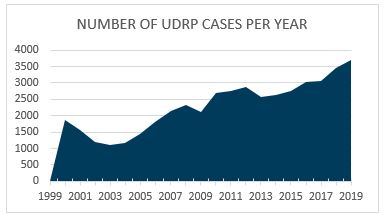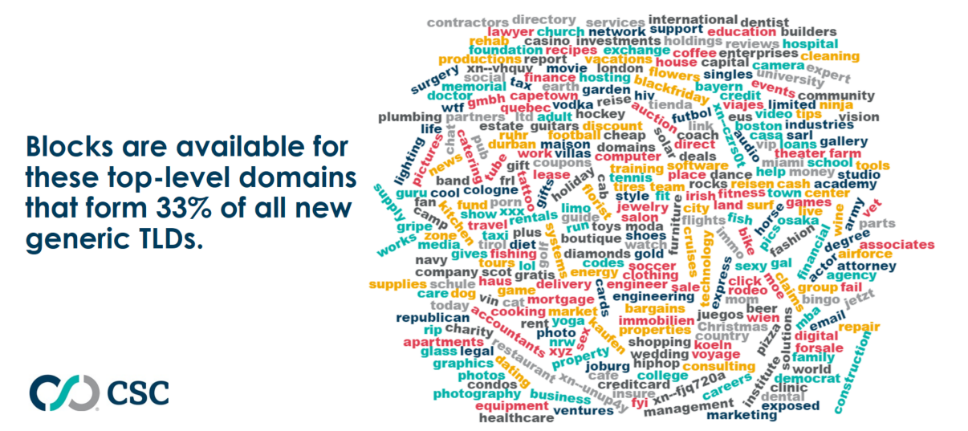Domain blocking
By Connie Hon, Domain Product and New gTLD manager Share this post



In our first installment, we introduced the various rights protection mechanisms brand owners can employ to protect their online brand, and how domain registrations equates to ownership and authority. In this second installment, we’ll cover the second prong—domain blocking.
What is domain blocking?
Domain blocking is a top-level domain registry service that allows brand owners to block third-party registrations by cybersquatters, and also block other brand owners with the same registered trademarks with domain names matching their trademarks on the second level. Second level simply means the string to the left of the dot such as “example” in “example.com.”
To understand blocking, we need to start from .XXX. Unlike .COM, the .XXX name space was created in 2011 by ICM Registry to be the sanctioned area for adult-themed content on the internet. The creation of .XXX caused a problem for brands that are not from the adult entertainment industry.
Non-adult entertainment brands could suffer from cybersquatting under the .XXX domain by nefarious actors, destroying brand equity while the bad actors gained traffic. Brands could register brand domain names in .XXX so as to avoid potentially costly recovery costs later. However, since most brands didn’t want ownership in an adult-themed name space, domain registration was not an option. So in Dec 2011, ICM Registry created a new product that enabled brands to block registrations of their trademarks in .XXX for 10 years. These were known as the Sunrise B blocks and are the pioneers of domain blocking.
Fast forward to 2019, blocked domain names could be exact matches, variants, contained marks, misspellings, typos, homoglyphs, or internationalized domain names.
Domain blocking: potential ownership at a fraction of the price
A blocked domain name does not resolve, so blocking should be applied when brand owners don’t intend to use the domain name. They’ll need to apply with the registry to override the block for that particular domain name if they want to ever start using it. Domain blocking is an essential part of a domain name strategy as it can give brand owners an authority[1] over the blocked domain name to almost the same extent as being the registrant of the domain name, yet at a fraction of the total registration fee.
How does domain blocking fit into my domain name strategy?
For two decades, defensive registrations were and still are, the most optimal way in which a brand can protect itself in domain namespaces. A brand-owned domain name meant that domain name was out of the reach of third parties and therefore could not be used for phishing, distribution of malware, or destroying the brand relationships with its customers, investors, and vendors.
However, the burden of defensive registrations is growing. As more users came online in the last 20 years, so did the number of infringing domain names. The number of Uniform Dispute Resolution Process (UDRP) cases grew by 214% from its lowest point in 2003 to its peak in 2018. The number of UDRP cases in 2019 is a record high since the World Intellectual Property Organization (WIPO) began recording cases in 1999.

One reason for this increase is the growth in the number of name spaces available in which anyone can register domain names. Close to 1,000 new generic top-level domains (gTLDs) such as .DOG and .CLUB have joined .COM on the internet since 2013. These gTLDs often have low barriers to registration in the form of low fees and little eligibility criteria. For brand owners, the clear and present danger is that it’s possible for anyone to register any brand in almost every gTLD.
Defensive registrations of brands across all of the available new gTLDs can be cost-prohibitive. Few corporations would actually register every product or service brand name and their variations in 1,000 new gTLDs. While defensive registrations are still an essential part of any corporate domain name strategy, domain blocks are increasingly gaining traction too.
With domain blocks in the post-new gTLD world, brand owners can effectively block registration of their brand name across several buckets of new gTLDs. Unfortunately as cost-effective as it sounds, not every gTLD is covered by a domain block. Presently domain blocks are offered by five new gTLD registries with coverage of their respective portfolio of new gTLDs. Together they form 33% of all new gTLDs.

gTLD coverage, benefits, and protection differ from block to block
With the more robust blocks, brand owners can block off all third-party registrations of their brand name in these new gTLDs, effectively acting as domain owners themselves. These blocks give the same kind of authority that brand owners would have if they registered all the domain names themselves, but at a fraction of the total registration fee.
Donuts Registry, for example, offers the domains protected marks list (DPML). This blocks third-party registrations, but allows other trademark holders with the same trademark to override the DPML block for a particular domain name to activate it. Donuts also offers the DPML Plus, which blocks all third-party registrations, including those from other trademark holders.
The baseline block of the newer domain blocks offered by ICM Registry offer protection from all third parties including other trademark holders. The trend in new gTLD domain blocks is moving towards fuller protection, reflecting what brand owners want out of domain blocks.
In the next installment of our four-part series we discuss how domain monitoring is used to protect your brands in name spaces that are not covered by blocks.
>> Contact us for more information on CSC’s TMCH and blocking services for new gTLDs.
Read Part 1: Introduction and domain registration
Read Part 3: Domain monitoring for brand protection
Read Part 4: Domain monitoring for policy compliance
[1] The more robust domain block is one that blocks off domain registrations from not only cybersquatters, but also other trademark holders who own the same trademark and have deposited it with the TMCH.